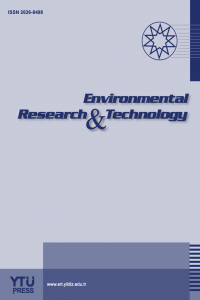Treatment of landfill leachate by anaerobic baffled reactor (ABR)
Anaerobic Baffled Reactor, Landfill leachate, Dilution rate,
___
- [1]. P.T. Williams, Waste Treatment and Disposal, 2nd Ed. John Wiley & Sons Ltd, England. 2005.
- [2]. P. Agamuthu, Solid Waste: Principals and Management with Malaysian Case Studies, Universiti of Malaya Press, Kuala Lumpur, 2001.
- [3]. S.R. Qasim and C. Walter, Sanitary Landfill Leachate, Technomic Publishing Company, Inc., Lancaster, Pennsylvania. 1994.
- [4]. A. Bagchi, Design of Landfills and Integrated Solid Waste Managemen, John Wiley & Sons, Inc., New Jersey. 2004.
- [5]. P.L. McCarty, "One hundred years of anaerobic treatment. Anaerobic Digestion 1981," Proceedings of the Second International Symposium on Anaerobic Digestion Held in Travemhunde, Federal Republic of Germany, 6–11 September. 1982.
- [6]. E. Neczaj, E. Okoniewska, and M. Kacprzak, "Treatment of landfill leachate by sequencing batch reactor," Desalination, 185(1-3), 357-362, 2005.
- [7]. G.G. Krishna, and P. Kumar, "Treatment of low strength complex wastewater using an anaerobic baffled reactor (ABR)," Bioresource Technology, 99(17), 8193-8200, 2008.
- [8]. A.A. Langenhoff and D.C. Stuckey, "Treatment of dilute wastewater using an anaerobic baffled reactor: effect of low temperature," Water Research, 34(15), 3867-3875, 2000.
- [9]. A. Arvin, M. Peyravi, M. Jahanshahi, and H. Salmani, "Hydrodynamic evaluation of an anaerobic baffled reactor for landfill leachate treatment," Desalination and Water Treatment, 57(42), 19596-19608, 2016.
- [10]. J. Liu, H. Zhang, P. Zhang, Y. Wu, X. Gou, Y. Song, and G. Zeng, "Two-stage anoxic/oxic combined membrane bioreactor system for landfill leachate treatment: pollutant removal performances and microbial community," Bioresource Technology, 243, 738-746, 2017.
- [11]. S. Renou, J.G. Givaudan, S. Poulain, F. Dirassouyan, and P.Moulin, "Landfill leachate treatment: review and opportunity," Journal of hazardous materials, 150(3), 468-493, 2008.
- [12]. K. Luo, Y. Pang, X. Li, F. Chen, X. Liao, M. Lei, and Y. Song, "Landfill leachate treatment by coagulation/flocculation combined with micro electrolysis-Fenton processes," Environmental technology, 1-9, 2018.
- [13]. N. Hendrasarie, and M.N. Trilta, "Removal of nitrogen-phosphorus in food wastewater treatment by the Anaerobic Baffled Reactor (ABR) and Rotating Biological Contactor (RBC)," Earth and Environmental Science, Vol. 245, No. 1, p. 012017, 2019.
- [14]. S. Park, K.S. Choi, K.S. Joe, W.H. Kim and H.S. Kim, "Variations of landfill leachate properties in conjunction with the treatment process," Environ. Technol., 22, 639–645, 2001.
- [15]. E. Neczaj, M. Kacprzak,nJ. Lach, and E. Okoniewska, "Effect of sonication on combined treatment of landfill leachate and domestic sewage in SBR reactor," Desalination, 204(1-3), 227-233, 2007.
- Yayın Aralığı: Yılda 4 Sayı
- Başlangıç: 2018
- Yayıncı: Yıldız Teknik Üniversitesi
Md. Ashik AHMED, Pranta ROY, Md. Hakimuzzaman SHAH, Debobrata Paul ARGHA, Debbrata DATTA, Riyadul Hashem RİYAD
Salih YILMAZ, Özgür ÖZDEMİR, Mahmut FIRAT
Benan YAZICI KARABULUT, Perihan DERİN, Mehmet İrfan YEŞİLNACAR, Mehmet Alı ÇULLU
Serdar GÖÇER, Ahmet DUYAR, Melike KOZAK, Kevser CIRIK
Marcelino Jr LUNAG, Melissa May BOADO
Asude HANEDAR, Burak GÜL, Elçin GÜNEŞ, Gül KAYKIOĞLU, Yalçın GÜNEŞ
Meryem AKSU, Pınar Nazire TANATTI, Büşra ERDEN, İsmail Ayhan ŞENGİL
